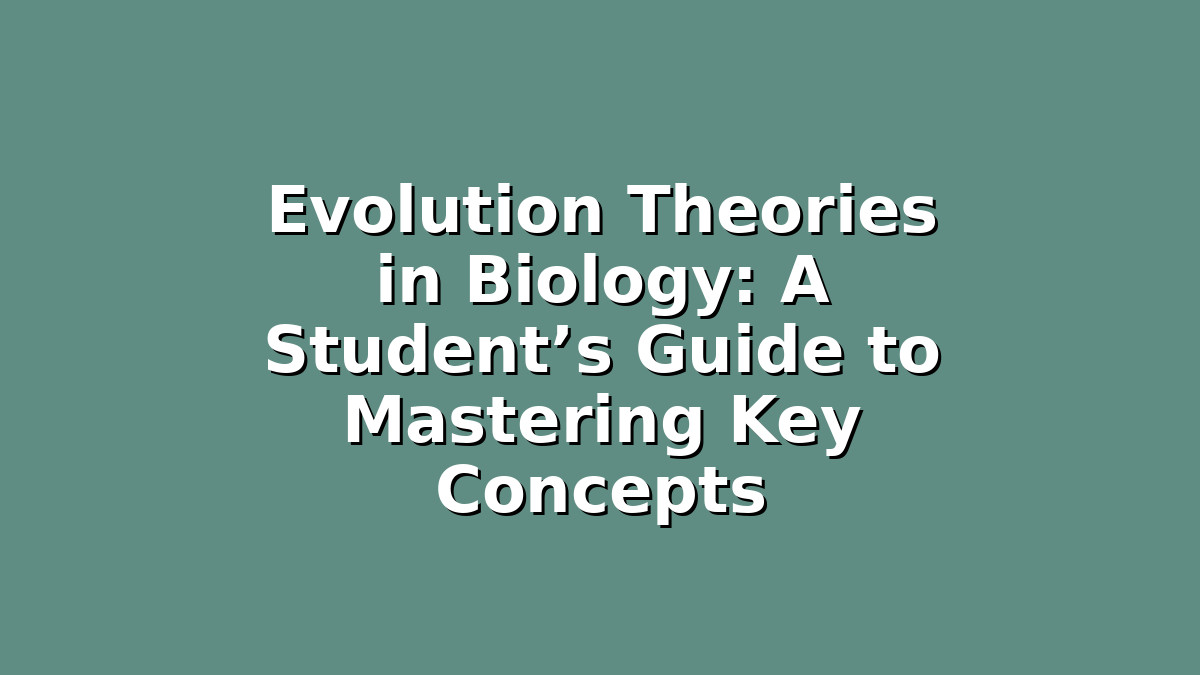Understanding evolution is fundamental for students studying biology, especially those preparing for exams. Evolution explains the diversity of life on Earth and the processes that drive change in species over time. But with several theories explaining how evolution works, it can feel overwhelming to grasp all the details and remember them during tests. This guide breaks down the main evolution theories in biology and provides effective study tips to help you confidently master the material.
Introduction to Evolution Theories
Evolution is the process by which populations of organisms change over generations through genetic variation and natural selection. The concept has evolved itself, beginning with early ideas and culminating in modern synthesis. When preparing for exams, students often encounter multiple evolution theories, including Lamarckism, Darwinism, and the modern synthesis. Each theory offers unique perspectives on how species evolve, and understanding these nuances is key to excelling in biology.
This article will explore three major evolution theories in detail and offer study strategies to help you learn and remember their concepts effectively.
—
1. Lamarckism: Understanding the Theory of Acquired Characteristics
One of the earliest theories of evolution was proposed by Jean-Baptiste Lamarck in the early 19th century. Lamarckism, also known as the theory of acquired characteristics, suggests that organisms can pass on traits they acquire during their lifetime to their offspring. For example, Lamarck believed that giraffes developed long necks because their ancestors stretched to reach higher leaves, and this trait was inherited by the next generation.
Key Points to Remember:
– Traits acquired during an organism’s life (like muscle strength or neck length) can be inherited.
– Evolution is driven by an organism’s needs and efforts to adapt.
– This theory has been largely discredited but is important historically.
Study Tips:
– Create comparison charts contrasting Lamarckism with later theories like Darwinism.
– Use mnemonic devices such as “Lamarck = Learned traits” to remember acquired characteristics.
– Practice explaining why Lamarck’s theory was eventually rejected, focusing on the role of genetics in inheritance.
—
2. Darwinism: Natural Selection and Survival of the Fittest
Charles Darwin revolutionized biology with his theory of natural selection, outlined in his 1859 book *On the Origin of Species*. Darwinism posits that evolution occurs through the natural selection of individuals with advantageous traits. These individuals are more likely to survive and reproduce, passing beneficial traits to their offspring.
Key Points to Remember:
– Variation exists naturally within populations.
– Organisms with traits better suited to their environment have higher survival rates.
– Over many generations, this process leads to adaptation and speciation.
– “Survival of the fittest” refers to the best fit to the environment, not necessarily the strongest.
Study Tips:
– Use diagrams to visualize natural selection, showing how populations change over time.
– Create flashcards of key terms: variation, adaptation, fitness, and selection pressure.
– Apply real-life examples like antibiotic resistance in bacteria to understand natural selection.
– Practice essay questions explaining the steps of natural selection and its impact on species.
—
3. Modern Synthesis: Integrating Genetics with Evolution
The modern synthesis, developed in the early 20th century, combines Darwin’s natural selection with Mendelian genetics. It explains evolution in terms of changes in allele frequencies within populations. This theory addresses how genetic mutations, gene flow, genetic drift, and recombination contribute to evolutionary change.
Key Points to Remember:
– Evolution operates at the genetic level.
– Mutation introduces new genetic variation.
– Gene flow and genetic drift affect allele frequencies independently of natural selection.
– The synthesis unifies disciplines like paleontology, systematics, and molecular biology.
Study Tips:
– Draw flowcharts to connect genetics concepts with evolutionary processes.
– Summarize the roles of mutation, gene flow, genetic drift, and selection in bullet points.
– Use practice problems involving allele frequency calculations to reinforce quantitative understanding.
– Watch educational videos or animations that explain the modern synthesis visually.
—
Study Strategies for Mastering Evolution Theories
Studying evolution theories requires both memorization and conceptual understanding. Here are some additional tips to help you succeed:
– Active Recall and Spaced Repetition: Regularly test yourself on definitions and key points to improve memory retention.
– Group Study: Discussing theories with peers can clarify doubts and reinforce learning.
– Mind Mapping: Create mind maps linking different theories and their components to visualize connections.
– Past Exam Papers: Practice writing short answers and essays on evolution to build confidence and identify gaps.
– Use Multiple Resources: Combine textbooks, videos, and online quizzes to cater to different learning styles.
—
Conclusion
Mastering evolution theories in biology is achievable with the right approach and dedication. By understanding Lamarckism, Darwinism, and the modern synthesis, you’ll gain a comprehensive view of how scientists explain the diversity and adaptation of life. Incorporate the study techniques outlined here to reinforce your knowledge and improve exam performance. Remember, evolution is not just a chapter in your textbook—it’s a fascinating story of life’s continual change and resilience.
Keep studying with curiosity and confidence, and you’ll be well-prepared to tackle any evolution-related question on your exam!
—

Responses